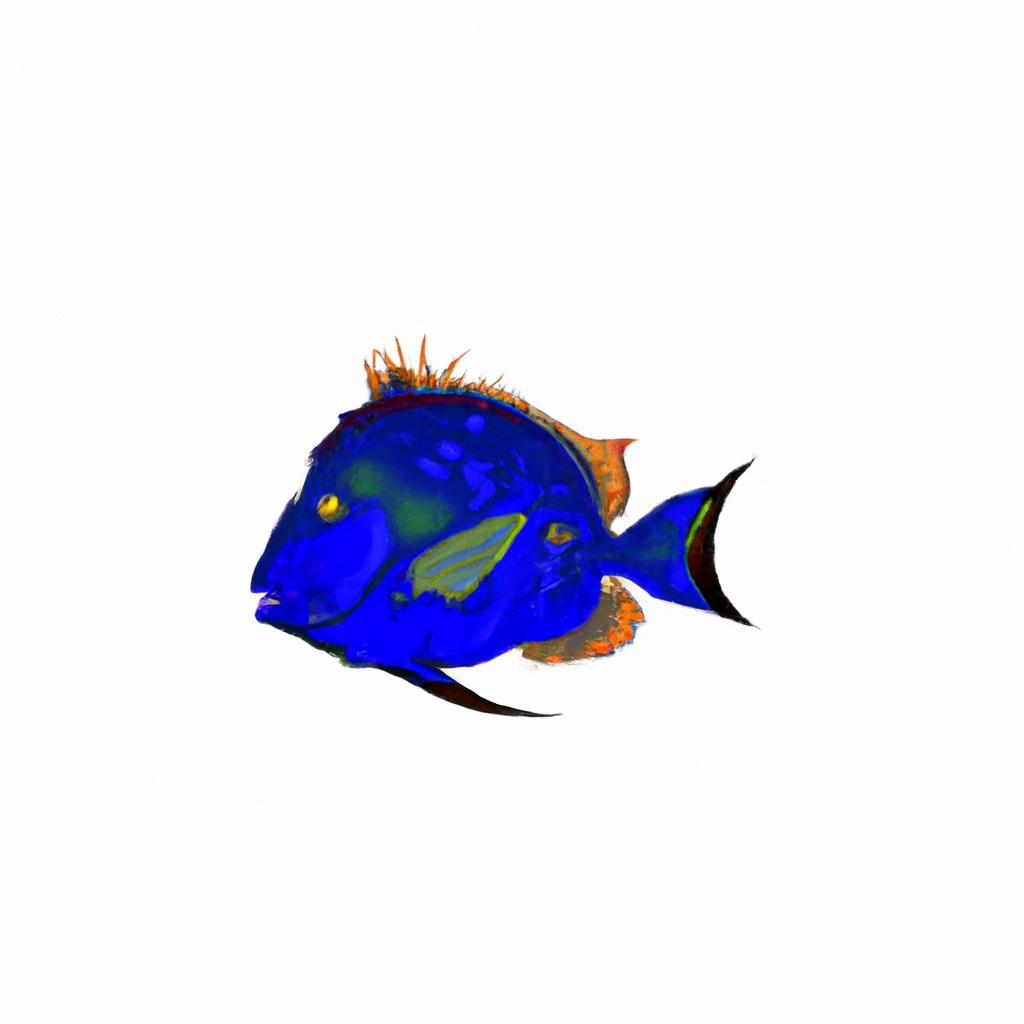The emperor, scientifically known by the name Lethrinus species, is a fish belonging to the family Lethrinidae. It is admired for its beauty, size and importance to the marine ecosystem. This article explores the fascinating world of the emperorfish, examining its characteristics, habitats, diets, breeding habits, and importance in the fishing industry.
Appearance and Characteristics
The emperor is a truly majestic fish, with a sleek body and long tail that exudes elegance and grace. Its coloration is varied, from shades of blue to silver, yellow to bright red. This striking combination sets it apart from the other fish species, and makes it instantly identifiable.
The large, protruding eyeballs of the emperorfish give it excellent underwater vision. It also has sharp, conical-shaped teeth that allow it to catch prey efficiently. It can weigh between 1 kg and 10 kg depending on its species and age.
Habitat and Distribution
The emperor is found in many oceans, but primarily in the Indo-Pacific. It lives in shallow and deep water, usually near corals, rocky areas or seagrass beds. These habitats offer the emperor a vital shelter and a plentiful food source.
The emperor fish thrives in tropical waters with temperatures between 23degC and 29degC. It prefers areas where the currents are moderate, as this allows it to move easily when hunting or looking for shelter. This species is more common in areas with a diverse marine life, which indicates its preference for healthy ecosystems.
Diet and Feeding Behaviour
The emperor is a carnivorous fish that feeds on a variety marine organisms in order to meet its nutritional needs. Its diet is primarily made up of small fish, crustaceans and invertebrates. The juvenile emperor fish feeds on plankton, until they are large enough to catch larger prey.
These majestic predators use a keen eye to spot potential prey at a distance. They use bursts to speed up and chase their prey. Emperor fish are known to have a voracious appetite. This makes them essential in controlling the population of smaller marine animals within their ecosystem.
Reproduction and breeding habits
The emperorfish undergoes a complicated reproductive process that begins with courtship rituals, culminating in the release fertilized eggs. During the breeding season, males display aggressive displays in order to attract females. The females, on their part, release their eggs into open water for the males to fertilize.
After fertilization, the eggs are left to develop on their own, floating in the water column. The eggs hatch and become larvae which drift along ocean currents to find a suitable habitat. This strategy increases their chances to reach areas with abundant food sources and increase their chances of survival.
Ecological Significance
The emperor is a key player in maintaining the balance within marine ecosystems. It is both a predator and a prey fish, and it regulates the populations of smaller invertebrates and fish. The health of corals reefs, for example, depends heavily on the presence of the emperor fish. They help control algae growth, and preserve the delicate eco-ecological balance.
The emperor fish is also a source of food for local communities and contributes to the fishing industry. Its meat is highly prized due to its delicious taste and nutritional value. The capture and sale of emperors fish is a vital source of income and sustenance for many coastal communities.
Conservation and Threats
Despite its importance, the emperorfish population faces a number of threats and challenges. The decline of the emperor fish is largely due to overfishing, destructive fishing methods, and habitat destruction. The use of dynamite and fine-mesh nets are two examples of indiscriminate fishing techniques that not only harm emperor fish but also its habitat and marine ecosystem.
To ensure the survival of emperor fish, it is essential to implement sustainable fishing techniques and protect critical habitats such as coral reefs or seagrass beds. Local communities, governments and conservation organizations need to work together to promote responsible fishing.
In conclusion
The emperor is one of the most majestic creatures in the ocean, thanks to its stunning beauty and ecological importance. Its appearance and habitat, diet, reproduction habits, and importance to maintaining marine ecosystems all highlight its crucial role in maintaining a delicate balance in the underwater world.
The emperor fish’s habitat and the survival of the species are both dependent on the preservation. It is also important for the health and resilience our oceans. We can ensure that this majestic species will continue to exist by adopting sustainable fishing techniques and protecting important marine habitats. Future generations will be able to see the magnificence of the emperorfish.
Emperor Fish: the Majestic Ruler in the Ocean
The emperor, scientifically known by the name Lethrinus species, is a fish belonging to the family Lethrinidae. It is admired for its beauty, its size, and the importance it plays in the marine eco-system.
The emperor is a truly majestic fish, with a sleek body and long tail that exudes elegance and grace. Its coloration varies from shades of blue to silver, yellow to bright red. This striking combination sets it apart from the other fish species, and makes it instantly recognizable.
The large, protruding eyeballs of the emperorfish give it excellent underwater vision. It also has sharp conical teeth which allow it to catch prey efficiently. It can weigh between 1 kg and 10 kg depending on its species and age.
The emperor is found in many oceans, but primarily in the Indo-Pacific. It lives in shallow and deep water, usually near corals, rocky areas or seagrass beds. These habitats offer the emperor a vital shelter and abundant food.
The emperor fish thrives in tropical waters with temperatures between 23degC and 29degC. It prefers areas where the currents are moderate, as this allows it to move easily when hunting or looking for shelter. This species is more common in areas with a diverse marine life, which indicates its preference for healthy ecosystems.
The emperor is a carnivorous fish that feeds on a variety marine organisms in order to meet its nutritional needs. Its diet is primarily made up of small fish, crustaceans and invertebrates. The juvenile emperor fish feeds on plankton, until they are large enough to catch larger prey.
These majestic predators use a keen eye to spot potential prey at a distance. They use bursts to speed up and chase their prey. Emperor fish are known to have a voracious appetite. This makes them essential in controlling the population of smaller marine animals within their ecosystem.
The emperorfish undergoes a complicated reproductive process that begins with courtship rituals, culminating in the release fertilized eggs. During the breeding season, males display aggressive displays in order to attract females. The females, on their part, release their eggs into open water for the males to fertilize.
After fertilization, the eggs are left to develop on their own, floating in the water column. The eggs hatch and become larvae which drift along ocean currents to find suitable habitats. This strategy increases their chances to reach areas with abundant food sources and increase their chances of surviving.
The emperor is a key player in maintaining the balance within marine ecosystems. It is both a predator and a prey fish, and it regulates the populations of smaller invertebrates and fish. The health of corals reefs, for example, depends heavily on the presence emperor fish. They help control algae growth, and preserve the delicate eco-ecological balance.
The emperor fish is also a source of food for local communities and contributes to the fishing industry. Its meat is highly prized due to its delicious taste and nutritional value. The capture and sale of emperors fish is a vital source of income and sustenance for many coastal communities.
Despite its importance, the emperorfish population faces a number of threats and challenges. The decline of the emperor fish is largely due to overfishing, destructive fishing methods, and habitat destruction. The use of dynamite and fine-mesh nets are two examples of indiscriminate fishing techniques that not only harm emperor fish but also its habitat and marine ecosystem.
To ensure the survival of emperor fish, it is essential to implement sustainable fishing techniques and protect critical habitats such as coral reefs or seagrass beds. Local communities, governments and conservation organizations need to work together to promote responsible fishing.
The emperor is one of the most majestic creatures in the ocean, thanks to its stunning beauty and ecological importance. Its appearance and habitat, diet, reproduction habits, and importance to maintaining marine ecosystems all highlight its crucial role in maintaining the delicate equilibrium of the underwater world.
The emperor fish’s habitat and the survival of the species are both dependent on the preservation. It is also important for the health and resilience our oceans. We can ensure that this majestic species will continue to exist by adopting sustainable fishing techniques and protecting important marine habitats. Future generations will be able to see the magnificence of the emperorfish.




